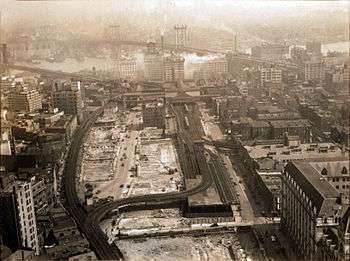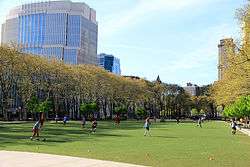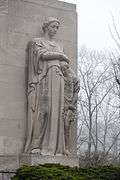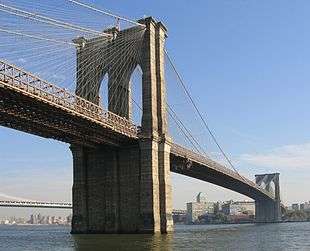Cadman Plaza
Coordinates: 40°41′53″N 73°59′26″W / 40.698121°N 73.990431°W






Cadman Plaza is a park located on the border between the Brooklyn Heights historic neighborhood and Downtown Brooklyn in New York City. Named for Reverend Doctor Samuel Parkes Cadman (1864-1936), a renowned minister in the Brooklyn Congregational Church, it is built on land reclaimed by condemnation in 1935 and was named as a park in 1939. The park borders Cadman Plaza West and Cadman Plaza East and the west and east sides of the plaza, respectively.[1]
Location
The plaza is bounded by Cadman Plaza East (formerly Washington Street) and Cadman Plaza West (formerly Ferry Road or Fulton Road),[2] and by the Brooklyn Bridge on the north and Tillary Street on the south. South of this park, between Tillary and Johnson Streets, lies the small Korean War Veterans Plaza. South of Johnson, the Kings County Supreme Court Building and Columbus Park, featuring a statue of Christopher Columbus, sit on land formerly used as a station for trolley cars. These parks, together with Whitman Park, form a mall from Brooklyn Borough Hall to the Brooklyn Bridge.
Memorials
Gaynor Memorial
A statue of William Jay Gaynor (1849–1913) is located in the northern end of Cadman Plaza Park. He was Mayor of New York City from 1910 to 1913. Beforehand, he was a journalist, a lawyer, and a New York Supreme Court justice, known for his tough stance on corruption. During his tenure as mayor, he tried to diminish the influence of Tammany Hall on city government.[1] Gaynor was wounded in an assassination attempt by an irate former civil servant in 1913. Gaynor was also well known for his social life, and he walked over the Brooklyn Bridge to New York City Hall and back to his home in Park Slope every day.
World War II Memorial
Inspired by Parks Commissioner Robert Moses’s desire to provide a World War II monument to each borough, this monument was created. It is a granite and limestone 24-foot-tall (7.3 m) memorial designed by Stuart Constable, Gilmore D. Clarke, and W. Earle Andrews, who worked in concert with the architectural firm of Eggers and Higgins.[3] The two larger-than-life sized high relief figures by sculptor Charles Keck (1875–1951) are located on the south facade, at opposite ends of the building. It honors Brooklynites who served in World War II. The full plan, however, was never fully built because of lack of funding.[3]
At the time of its dedication, November 12, 1951, these were said to be the largest sculptures in New York City.[1][4] Two figures representing Victory and Family stand to the sides of the inscription which reads:
This memorial is dedicated to the heroic men and women of the borough of Brooklyn who fought for liberty in the second world war 1941-1945 and especially to those who suffered and died may their sacrifice inspire future generations and lead to universal peace[3]
The memorial includes a wall in the main auditorium inscribed with the names of 11,000 Brooklynites who died in the war.[5] The area is now used for Parks Department storage and is closed to the public.[6]
The War Memorial was restored in 1977 and was intended to serve as a community facility for veterans’ groups and arts organizations. The building was actively used by committees of Community Board 2, ceremonies by veterans’ groups, musical groups, theater groups, exercise classes and more. This stopped in the early 80s and only one organization is left in the building.[7] The last active use of the building may have been by Brooklyn College for art exhibits. In May 2006, however, the organization was evicted. In the 1980s, the city began using the granite and limestone building basement for storage.[8] Access is restricted. To view the plaques and list of names inside, relatives of World War II vets must make appointments.
The condition of the building is poor. The New York City Parks Department estimates the building needs $20 million for staffing and renovations, including a wheelchair-accessible entrance and air conditioning.[6] In 1987, the chairman of Community Board 2 signed an agreement with the Parks Department allocating $540,000 for an elevator and other improvements to the memorial. This work was never done.[5]
References
- 1 2 3 "Cadman Plaza Park - History". nycgovparks.org. Retrieved 2012-03-25.
- ↑ "Map of Brooklyn 1887" on the Internet Map Archive website
- 1 2 3 "Cadman Plaza Park - Brooklyn War Memorial". nycgovparks.org. Retrieved 2014-03-18.
- ↑ Freudenheim, Ellen. "Brooklyn War Memorial: A Historic World War II Memorial in Brooklyn Heights". about.com. Retrieved 2014-03-18.
- 1 2 Geberer, Raanan (2012-06-13). "Army soldiers rededicate Brooklyn's shuttered, decaying WWII memorial". Brooklyn Daily Eagle. Retrieved 2014-03-18.
- 1 2 Briquelet, Kate (2012-11-11). "Public can't visit Brooklyn War Memorial on Veterans Day". New York Post. Retrieved 2014-03-18.
- ↑ Gebere, Raanan (2012-06-14). "Vets rage over Brooklyn's neglected WWII memorial: Many people don't even know shuttered, unkept edifice exists". Brooklyn Daily Eagle. Retrieved 2014-03-18.
- ↑ Tracy, Thomas (2010-11-12). "Vets outraged by fallen war memorial in Brooklyn Heights". Brooklyn Paper. Retrieved 2014-03-18.
External links
| Wikimedia Commons has media related to Cadman Plaza. |
